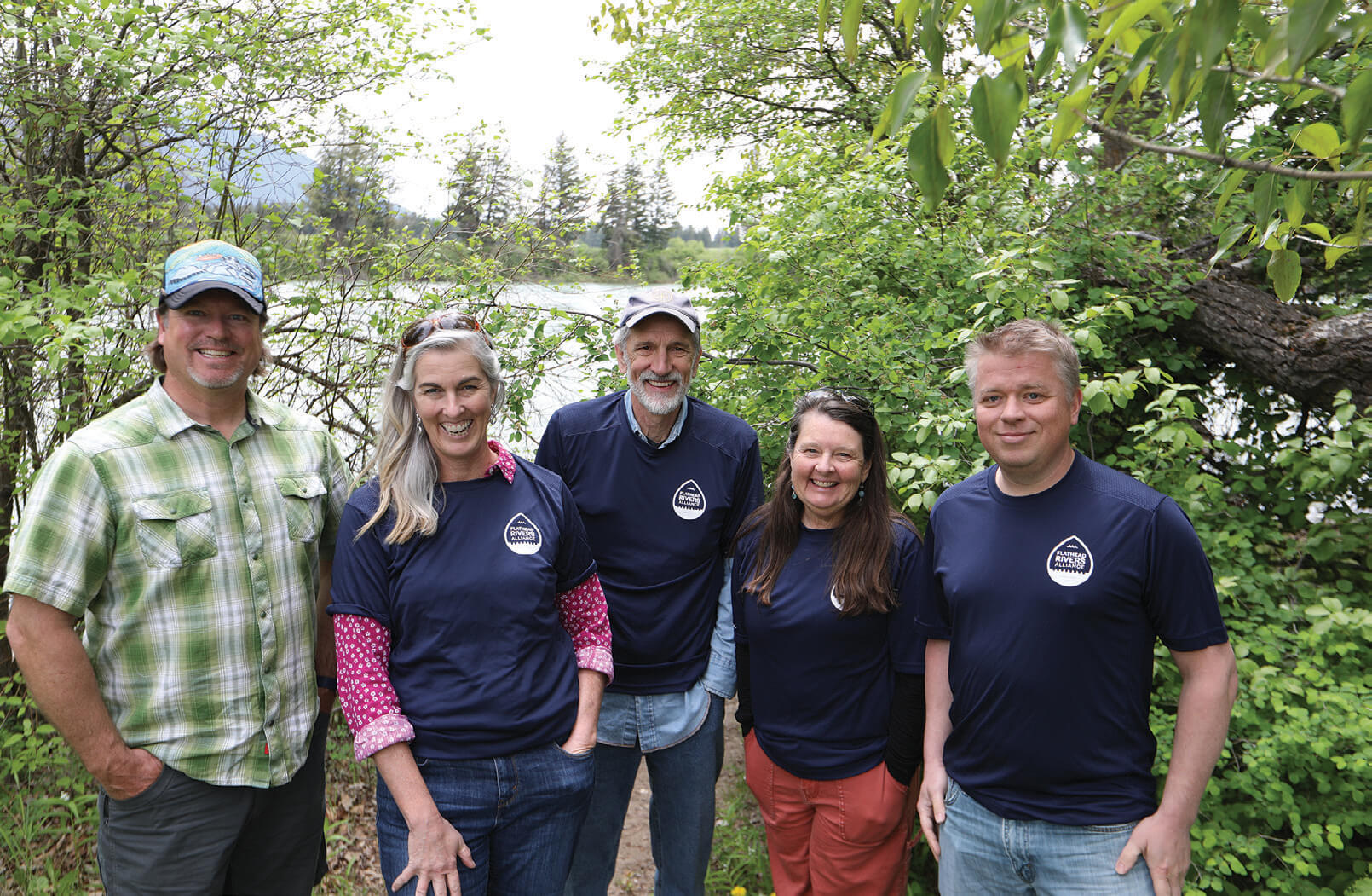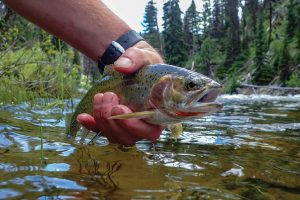
02 Feb Round Up: Nonprofit Spotlight: Flathead Rivers Alliance
In 2019, diverse stakeholders including agencies, guides, outfitters, landowners, businesses, and community members gathered to form the Flathead Rivers Alliance, a nonprofit organization that has since led collaborative efforts to safeguard the future of Montana’s Flathead Wild and Scenic River system. The organization’s mission is deceptively simple: Support and enhance the outstandingly remarkable values of the three forks of the Flathead, which are defined by the National Park Service as recreation, scenery, wildlife, botany, geology, fisheries, water quality, ethnography, and history. And that’s where the simplicity ends. Responsible ecological management and the inevitable balancing act to support and sustain the delicate river ecosystem amidst escalating use and visitation is a complex cooperative challenge. But for Flathead Rivers Alliance Watershed Coordinator Sheena Pate, the Flathead Rivers Alliance team, their community partners, and the hundreds of volunteers who share in the vision of a healthy Flathead in perpetuity, that challenge is worth the fight.

An angler on the Flathead Wild and Scenic River holds a native westslope cutthroat trout. Montana Fish, Wildlife & Parks
Here, Pate details the daily work, the wins, and the worries that drive and define the Flathead Rivers Alliance mission.
Big Sky Journal: Why was the Flathead Rivers Alliance created and what is its mission?
Sheena Pate: Usage and visitation on the 219-mile Flathead River has dramatically increased over the last decade without a sole dedicated organization to boost responsible recreation education and stewardship. Additionally, regional resource-management agencies have been increasingly challenged in their efforts to mitigate river-system threats: invasive aquatic species, climate impacts, a host of recreation related pressures, and water quality.
We know that we can’t do this alone, and that there are many other organizations and individuals doing great work for the waters of the Flathead. That’s why we believe in the power of a collective vision, of a resilient and healthy river ecosystem fostering a community where people interact respectfully and responsibly. Flathead Rivers Alliance has positioned itself as a facilitator of communication, discussion, and public forum on issues surrounding the Flathead headwaters and has become an instrumental partner with Flathead National Forest, Glacier National Park, and Montana Fish, Wildlife, & Parks (MT FWP) — the river’s cooperative managers.
BSJ: Why is your focus specifically on the Flathead River system, and what area does that include?
Pate: Less than half of one percent of the nation’s rivers are protected under the 1968 Wild and Scenic Rivers Act. Montana has approximately 169,829 miles of river, of which only 388 miles are designated as wild and scenic — approximately two-tenths of one percent of the state’s river miles. Designated rivers must be managed for free-flowing conditions, outstandingly remarkable values, and outstanding water quality. The Flathead River system is one of Montana’s three designated Wild and Scenic Rivers and spans 219 miles, draining approximately 4,369 square miles in northwestern Montana and southeastern British Columbia. It contributes approximately 85 percent of the water that flows into Flathead Lake, the largest natural body of freshwater in the western United States and one of the cleanest lakes of its size in the world. The Flathead not only serves as the headwaters of the Columbia River, but is also the largest tributary of the Clark Fork River. Its significance as a high-quality water source for consumption, recreation, and sustainment of one of the wildest, most biologically diverse and intact ecosystems in the temperate zones of the world cannot be denied.
The three forks of the Flathead include the traditional lands of the Salish (Selis), Pend d’Oreille (Qlispe), and Kootenai (Ktunaxa) people, who have stewarded the landscape for over 10,000 years. The North Fork originates in southeastern British Columbia and flows south across the United States border, where it is flanked by Glacier National Park on its east and the Flathead National Forest on its west. The headwaters of the Middle Fork flow from the Bob Marshall and Great Bear wilderness areas, between Glacier National Park to the north and the Flathead National Forest to the south, before converging with the North Fork at Glacier’s southernmost point. The headwaters of the South Fork flow from the Bob Marshall Wilderness through Hungry Horse Dam, before joining the Flathead 10 miles below the confluence of the North and Middle forks.
BSJ: Tell me about your current projects and outreach endeavors. What has been your greatest win? And your most pressing current concern?
Pate: Through education, stewardship, and partnerships, Flathead Rivers Alliance works alongside communities and river management agencies to maintain the health of the Flathead, while ensuring current and future access and enjoyment for all. As residents and visitors alike, we realize that every individual plays a part in keeping the three forks of the Flathead pristine for future generations. That’s why active stewardship is such a critical piece of the puzzle. We work with agency partners to identify infrastructure problems and river access needs, and assist in fundraising to implement these improvements. Together, we get our hands wet and help however we can to make these projects a success.
Current projects and outreach efforts are focused on river awareness education, responsible recreating initiatives, Americans with Disabilities Act accessibility, capacity building around water-quality monitoring, and so much more. The 2022 Flathead Waters Cleanup was another resounding success: Participants removed over 5,100 pounds of trash, improving 150 miles of riverbank and lakeshore. We also teamed up with Backcountry Hunters & Anglers’ Armed Forces Initiative to install two permanent, loaner life-jacket stations at popular river access sites.
Aside from the urgency to educate and provide tools to the public on how to respectfully and responsibly recreate on the river system, management of the three forks of the Flathead is one of the most pressing current concerns. Flathead National Forest and Glacier National Park currently manage the 219 miles of the three forks of the Flathead River under the Flathead Wild and Scenic River Management Plan (1980), the Flathead River Recreation Management Direction (1986), and the current editions of the Glacier National Park General Management Plan (1999) and the Flathead National Forest’s Forest Plan (2018). A new comprehensive river management plan is required and needed to reflect the current landscape, especially with the jump in use over the last decade. Agencies are mandated to manage the resource to ensure its outstandingly remarkable values, water quality, and free-flowing conditions remain. The public is a critical piece of the planning process and Flathead Rivers Alliance was established to not only spearhead long-term education and stewardship activities, but also to ensure public input during planning processes.
BSJ: What can the health of our river systems tell us about the health of the region?
pate: Rivers are a lifeline to this ever-changing planet, supplying essential drinking water, supporting livelihoods, and providing sanctuary to some of the most diverse and sensitive wildlife. The health of the river ecosystem directly affects the quality of the water and all that it supports. Warming temperatures, the threat of invasive species, and human-caused degradation may seem trivial, but they have significant implications to this vital natural resource. Rivers and precipitation, like wildlife, don’t recognize political borders. Montana may have some of the cleanest and ecologically diverse river systems on the planet, but what becomes airborne in a watershed across the ocean can affect the delicate chemical and habitat relations of its river ecosystems. Any impact to a river’s health has implications for those downstream; we are clearly connected by water. Finding common ground seems daunting these days, but we don’t have the luxury of time.
The Flathead has been on borrowed time thanks to perched glaciers pulsing cold, clean, clear water, which provides a robust habitat for keystone species like the sensitive native westslope cutthroat and bull trout. MT FWP fisheries biologists have led some of the largest conservation projects in the country aimed at restoring native westslope cutthroat trout. In the Middle Fork’s old glacier gravel floodplain, scientists at the Flathead Lake Biological Station have been studying stonefly larvae in groundwater at depths of 250 feet, nodding to the interconnectedness of our river and fringe ecosystem. Like the two native trout, stoneflies are indicator species of a river’s health. In the Flathead watershed, there have been as many as 100 different stonefly species — one-fourth of all stonefly species in North America. These cold-water dependent species risk extinction as temperatures increase and threats to water quality rise. From glaciers to groundwater, the vitality of these species tells a story of the health of the river system. What we do now has never been more critical.
You can help safeguard the future of the river system by subscribing to Flathead Rivers Alliance’s monthly eNews, familiarizing yourself with its online resources regarding river visitation, donating to the cause, or joining a river ambassador or citizen science volunteer team. Learn more at flatheadrivers.org.




No Comments